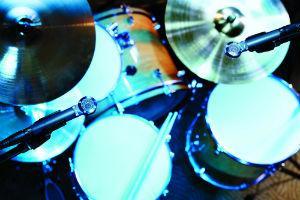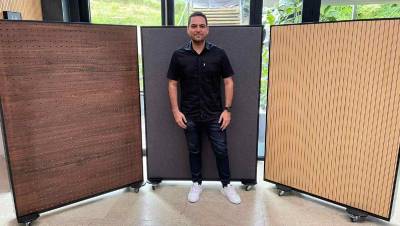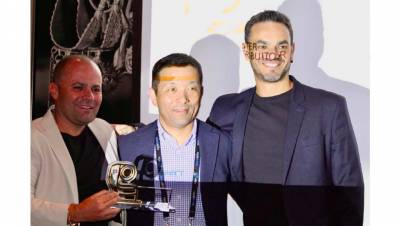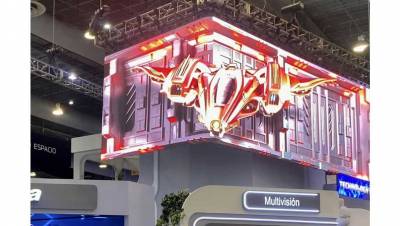 Good sound in shows depends, in large part, on microphones for artists and musical instruments. In recent developments aesthetics play an important role in brand identification.
Good sound in shows depends, in large part, on microphones for artists and musical instruments. In recent developments aesthetics play an important role in brand identification.
Richard Santa Sanchez
For tenor José Carreras' concert on May 11 in Bogotá, Colombia, three weeks earlier its organizers looked for a supplier that had 48 high-quality microphones used for classical music concerts. But neither in this country, nor in the rest of Latin America, is there a rental company that has that number of specific microphones.
It is at this point where the planning of a show comes to play a fundamental role, because it can end up affecting the quality of the sound by not meeting the technical requirements and leading the event to failure. This was pointed out by Miguel Domínguez, from the VCR company.
He indicated that "this gives an idea that the market in Latin America is not prepared to suddenly assume demanding requirements in productions of very high-level international shows. There are few companies dedicated to the production of shows that have really good sound equipment, with the latest technology. And even these are not ready to assume, without good planning well in advance, the requirements that large events can pose."
It's easy for a company to have a lot of $100 microphones in its inventory, but not $2,000 microphones required in high-quality shows. The same goes for audio consoles. In any show there are digital consoles of $ 10,000 dollars, but there are very few still those who invest a budget of 50 or 100 thousand dollars in a high-end digital console for live sound.
But this lack of the Latin American market in entertainment equipment also becomes an opportunity for the industry, because manufacturers and those who are dedicated to renting, have the challenge of providing state-of-the-art equipment to a market of shows in frank growth in the region.
Digital sound
The arrival and massification of digital sound in Latin America makes the requirements of equipment for shows increasingly demanding, especially in terms of microphones and consoles. Likewise, there are many options offered by the market to meet these needs.
In this regard, Aicardo Pardo Gutiérrez, market development engineer at Yamaki, said that one of the biggest advances that the industry has brought to entertainment is related to radio frequency.
"This has become a very delicate point in events and big shows. Now there are systems that deliver spectrum analysis, automatic frequency assignment and direct communication with hand and body transmitters, to remotely control their functions so that frequency changes are resolved remotely," he explained.
For Miguel Domínguez, digital microphones represent the most advanced technology in the field of microphones for shows, continuing with the latest technological trends in the field of digital audio and in the improvement of the remote control of the equipment and its integration, although they are not commercially implemented.
He said that "most of the new microphones deliver AES42 signal, a variation of the AES3 or AES/EBU standard, which allows Phantom power to be delivered to condenser microphones. The other great advantage of the AES42 is the possibility of remotely controlling the microphones, in terms of their directivity pattern, attenuation, filters, etc."
No cables
Today there are few scenarios in which wireless microphones are not used. These systems are used, above all, in live shows in which artists require mobility, such as plays and concerts. In these cases, not only wireless microphones are used, but also the wireless personal monitoring system.
Engineer Julio Bracho, director of Pro-Audio sales at Sennheiser Mexico, commented that there are three characteristics that speak of the quality of a wireless microphone: the bandwidth it handles, the filter and the quality of the capsule that is used.
"A professional series handles a bandwidth of up to 184MHz, uses an extremely thin filter that allows you to tune a frequency in steps of 5KHz and the capsule depending on whether it is the handheld or pocket transmitter offer you a variety of capsules of the finest quality, providing great performance on stage, "- Added.
Wireless systems are becoming a standard for shows. According to Aicardo Pardo Gutiérrez, visual cleanliness on stages, the comfort of the artist and their quality have made them a mandatory element. At the same time, it is one of the greatest challenges of evolution for companies due to the advance of communications and, therefore, the use of the radio frequency spectrum of the countries.
But some manufacturers integrate the remote control of wireless microphone receivers and transmitters with digital consoles, making it possible from the console itself to control wireless systems. Applications are also being implemented for iPad and iPhone that allow you to control integrated systems.
Other wireless microphone systems, widely used especially in the United States, are those intended for musical instruments. Miguel Domínguez explained that they use a digital transmission system of the 24-bit signal with 88.2 KHz of sample rate, without a compression system in the transmission, reaching its frequency response to transmit the fundamental note of a five-string bass, from 32 Hz to the highest frequencies and harmonics of any instrument.
Brand Differentiator
But it's not just technology that counts in the competition within the microphone market. Manufacturers have also turned design into a brand. Aicardo Pardo Gutiérrez said that form and aesthetics are his identifier in front of any audience, and that is why it is very important.
"Technology is also dependent on aesthetics, because it obeys the location of its batteries, access to configuration menus and the possibility of varying its capsules. Aesthetics is the added value that must be inherent in technological advancement and the ergonomics of its use," he said.
The aesthetic in the microphones also became an accessory for artists and that's why they should look good. Julio Bracho reported that today personalized microphones are offered so that artists can choose from a different range of colors, as in the case of Madonna who had one in gold color that was according to all her scenery and costumes during her presentation at the Super Bowl; others prefer to make a special design where crystals of different colors will be embedded, as in the case of Katy Perry.
Regarding the behavior of the market in this segment of the audiovisual industry, the representatives of Yamaki and Sennheiser agreed that the market for microphones for shows had a great year during 2011 and that the expectations for this year and the following are not less.
Aicardo Pardo Gutiérrez described the situation as excellent, because "the global crisis has allowed us to look at the Latin American market with a different perspective, where of course Colombia is going through a good time. For example, it is already easier to negotiate some conditions that were previously unimaginable. Overall we had significant growth and we expect us to continue along that same curve this year."
**Frequent errors
The three experts pointed out the most frequent errors in the field of microphones in Latin America:
*Not having installed the equipment in time with the appropriate requirements.
*Failure to do properly planned sound checks with musicians.
*Pretend to do events with several musical groups, each of which requires different adjustments. A lot of quantity and little quality.
* Not making a correct coordination of frequencies, especially when it comes to multichannel systems of a certain size.
* Not having the correct calibration of P.A. systems and monitors with portable audio analysis systems and the review of all wiring, both analog and digital.
*Failure to properly position remote antennas.
* Assign transmission frequencies of the microphones without a previous analysis, or thinking that the situation that was effective on one side will be on another.


























Leave your comment